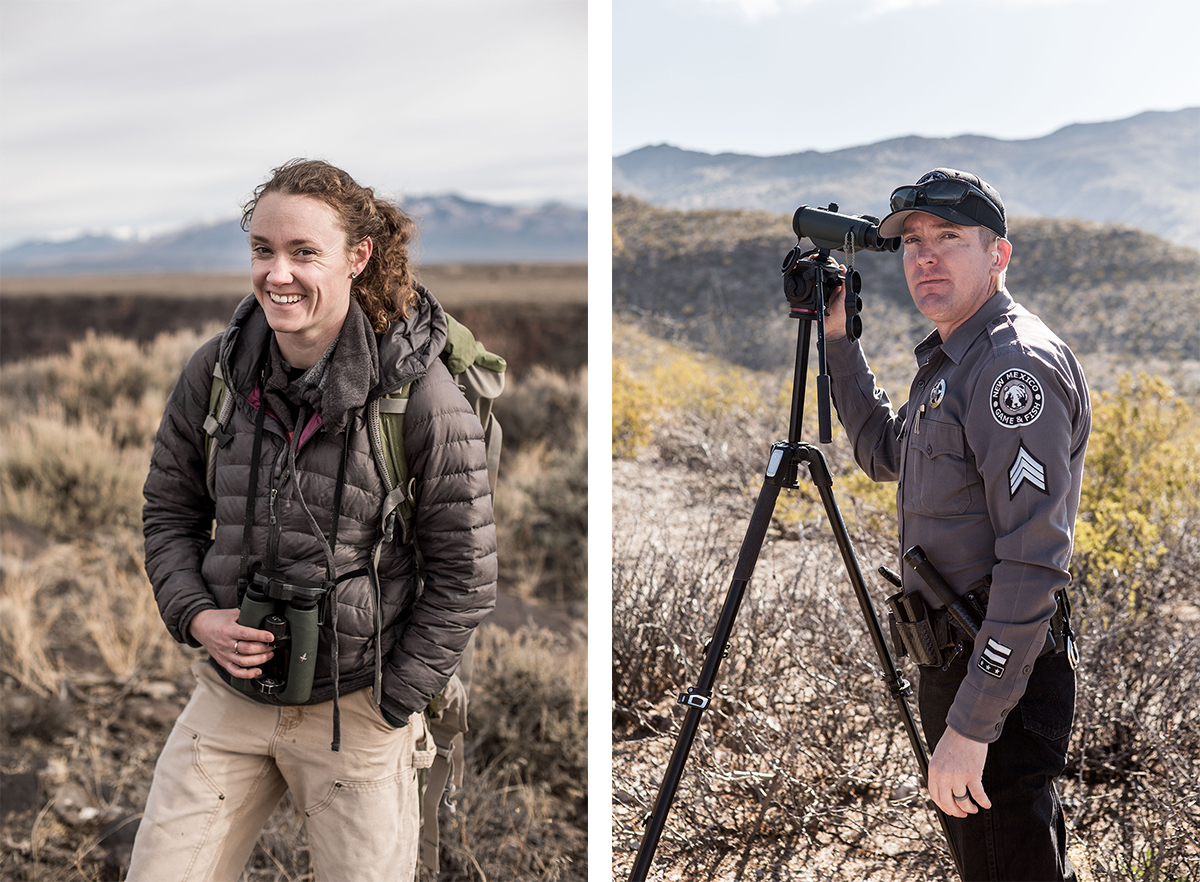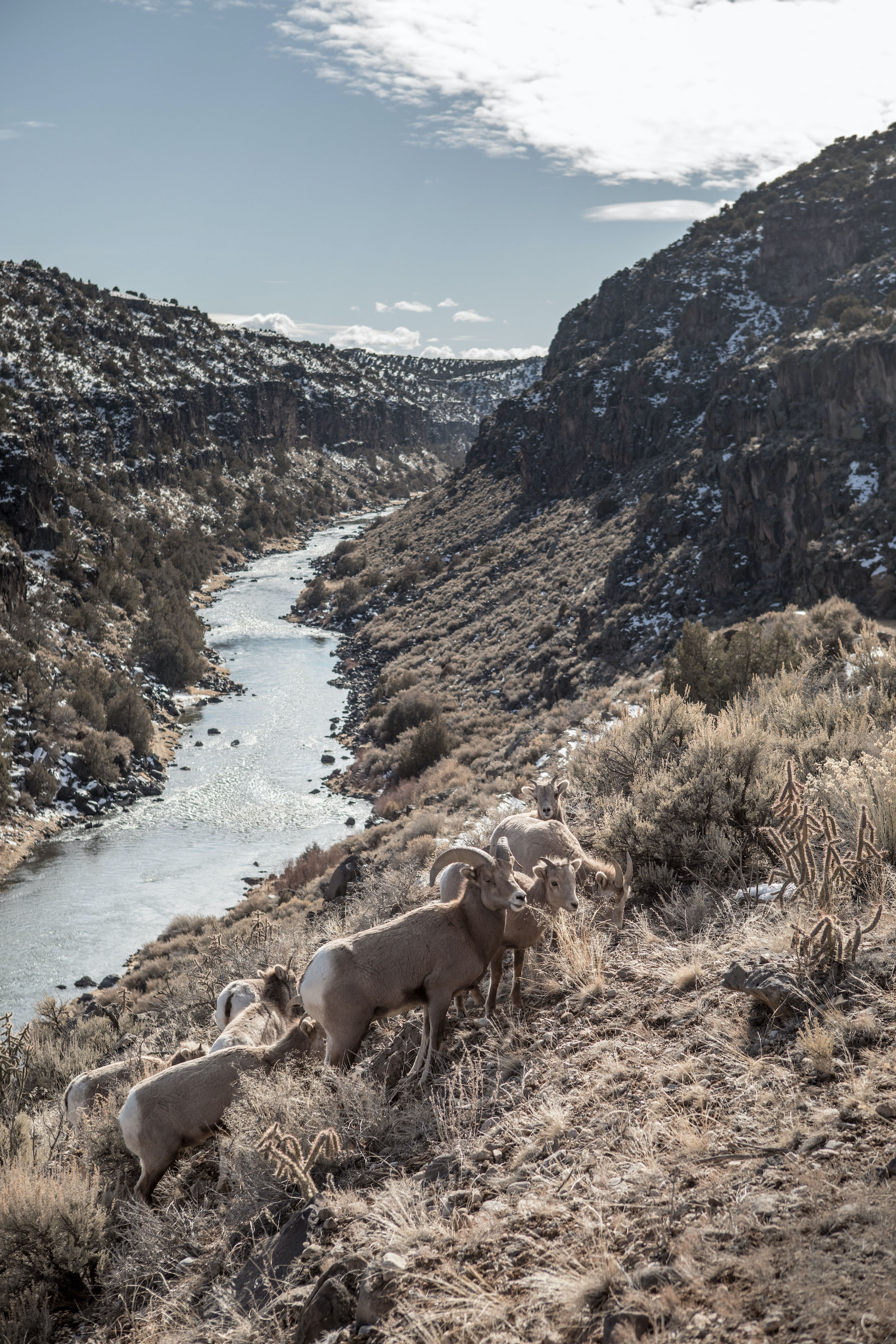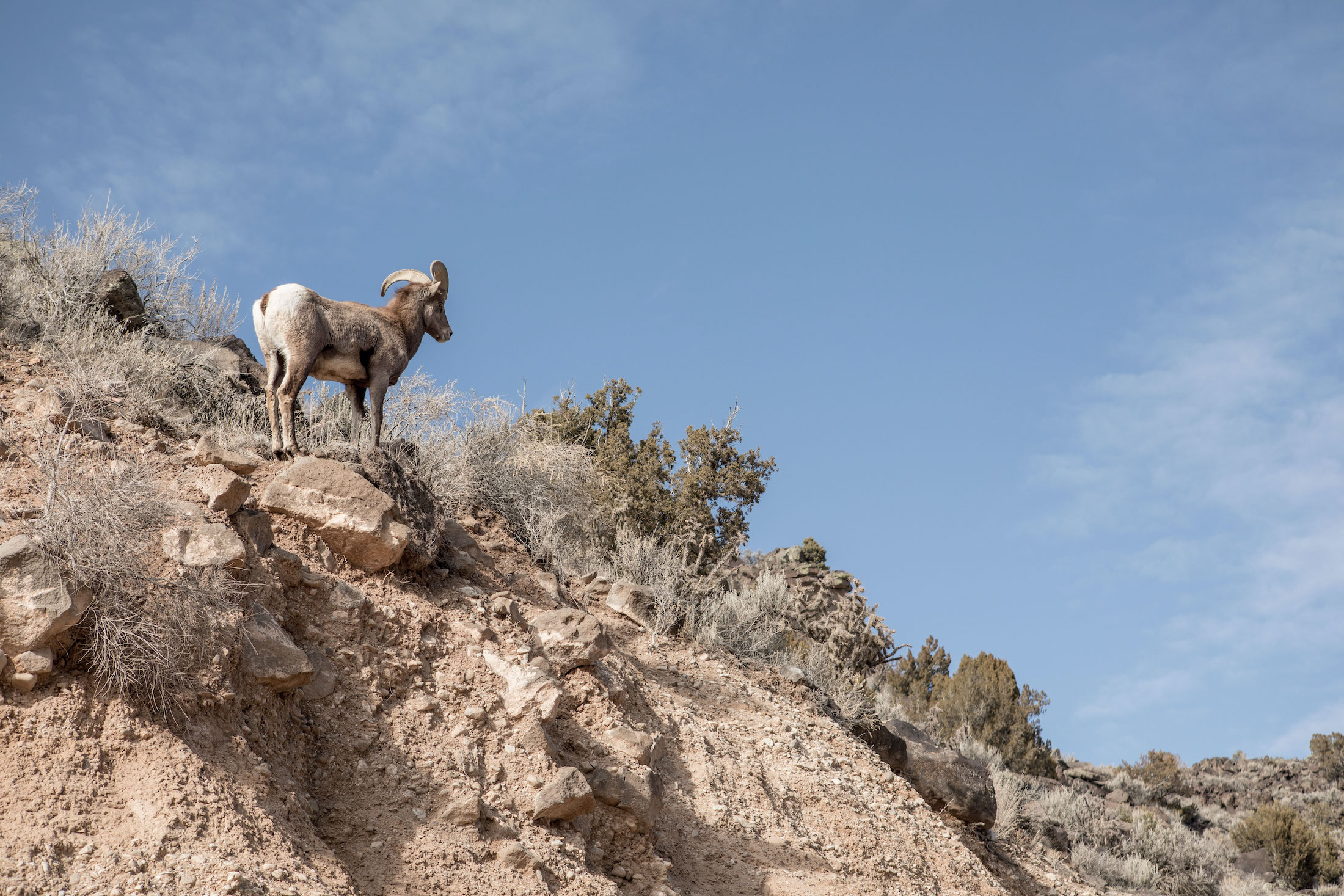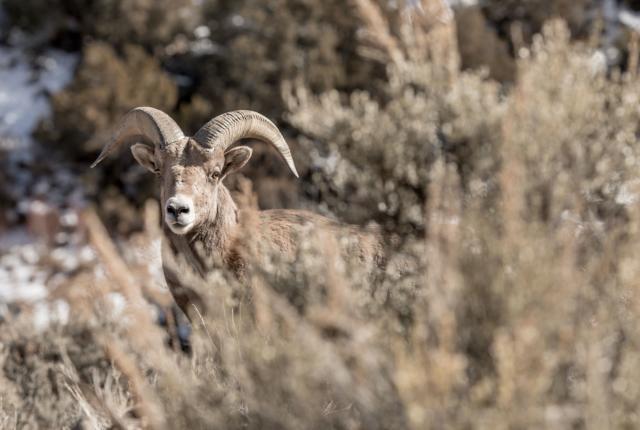Above: The New Mexico Department of Game and Fish estimate about 1,700 Rocky Mountain and 1,100 desert bighorn sheep roam the state. Photographs by Minesh Bacrania.
STANDING ON THE RÍO GRANDE GORGE BRIDGE, outside Taos, I pan the scenery with binoculars, wondering if the handful of other tourists and day-trippers are aware that there is more to admire than the spectacular view: Rocky Mountain bighorn sheep may be out there.
Facing north, I closely search the western wall of the gorge, where bighorn often bed down, but all I see is juniper trees and rocks. The problem isn’t my binoculars. Finding bighorn takes patience and, at times, a very experienced eye. As a former New Yorker, I’m more accustomed to looking up from the bottoms of “canyons” lined with 1,000-foot towers of steel and glass. The bridge I am standing on is about 650 feet above the Río Grande del Norte; far below, the river is a thin navy-blue ribbon. Here, surrounded by the flat Taos Plateau volcanic field and distant alpine peaks of the Sangre de Cristo Mountains, it’s easy for someone raised at sea level to forget we’re already 7,000 feet high.
Looking for bighorn requires heading to higher altitudes and looking up at steep mountainsides or into a gorge, where these animals are adept at negotiating precarious outcroppings. There’s a very important reason this herd is extra special to New Mexicans: Fourteen years ago, there wasn’t a single bighorn in the gorge.
As you head east toward the mountains along US 64, the only hint that bighorn have returned is a yellow road sign stamped with the black silhouette of a ram. Today, around 400 live in and around the 54-mile-long rift, which starts in southern Colorado and cuts a winding gash through the landscape that ends near the village of Pilar.
Statewide, the numbers are a testament to the work of state, tribal, and federal biologists. About 1,700 Rocky Mountain and 1,100 desert bighorn sheep roam throughout New Mexico, according to New Mexico Department of Game and Fish biologists.
Prior to European colonization, biologists estimate that 1.5 million bighorn lived in North America. That number stands at 80,000 to 90,000 Rocky Mountain and desert bighorn today. In the early 1900s, New Mexico’s Rocky Mountain bighorn were extirpated—completely removed from the wild—by unregulated hunting as well as disease transmission between domestic and wild sheep. Decades of restoration work has brought the native subspecies back to the New Mexico landscape. But the work is far from over.

Above: Biologist Caitlin Ruhl scans for Rocky Mountain bighorn in the Rio Grande Gorge.
I LEARNED A THING OR TWO about how to spot bighorn from Caitlin Ruhl, one of two bighorn biologists at the Game and Fish Department, where I also work. Last December, I joined her and a team of biologists and conservation officers from our department and the Bureau of Land Management, plus volunteers, including members of the New Mexico chapter of the Wild Sheep Foundation, for an annual survey of bighorn living in and around the gorge. While ski season was well under way and many visitors to Taos were headed to the slopes, the team hiked up and down the gorge to count rams, ewes, and lambs. Our goal was to get a new population estimate and make sure bighorn were still thriving and that their population was healthy and stable.
It was a good day to look. That was Ruhl’s assessment of the clear, crisp, and cold 19-degree morning as we stood in the parking lot of a rest area near the bridge. Likely it was too cold for most people to want to take a morning stroll along the rim of the gorge. For Ovis canadensis canadensis and the scientists looking for them, the weather was just right, with great visibility. “When it’s too hot out, bighorn don’t want to exert themselves as much,” Ruhl said.
In addition, their mating season, which runs from November to December, was on. That meant the rams would be more active, ready to fight over mates.
Ruhl joined the department six years ago and has spent most of her time as a bighorn biologist. Originally from Wisconsin, she developed a passion for the outdoors as a child, despite growing up within five miles of downtown Milwaukee. She always had an interest in studying large mammals, she said. Before joining Game and Fish in New Mexico, she worked as a wildlife technician at Yellowstone National Park.
“From a public viewing standpoint, this is probably our most valuable herd in New Mexico,” she said of the Taos bunch.
Bighorn were absent from the gorge until 2006, when Taos Pueblo translocated 23 bighorn from tribal lands near Wheeler Peak. In 2007, our department released 25 additional sheep from the Pecos Wilderness.
Ruhl positioned herself on a rocky outcropping with her binoculars. The best way to spot a bighorn? Look for the animal’s telltale white rump. Unlike bugling elk, bighorn do not make loud vocalizations. Instead, she explained, researchers and wildlife watchers should listen for two sounds: ram horns clashing during a fight or loose rocks falling as the animals move across the gorge.
Read more: An autumn elk hunt in Valles Caldera National Preserve reaps unexpected rewards.
Every couple hundred feet, Ruhl set down her backpack carrying water and snacks and scanned the gorge. She located the sheep, made note of whether there were rams, ewes, or lambs, and estimated their ages before moving on to another section of the canyon. I struggled to find the bedded-down sheep she so easily picked out. Bighorn had even passed through where we walked. There were hoofprints as well as droppings that looked like small piles of dark brown piñon seeds.
The Rocky Mountain herd in the Río Grande Gorge is only one of many reintroduced by state and tribal biologists since 1940, when the department conducted its first successful relocation, moving two Rocky Mountain ewes and one ram from Banff National Park, in Alberta, Canada, to the Sandía Mountains. Two more transplants from Banff occurred in 1941 and 1942. Since then, Game and Fish has conducted transplants in almost every decade, resulting in a total of 614 Rocky Mountain bighorn translocated by the department.
All across the state, Rocky Mountain bighorn have reclaimed their native range, from the Manzano Mountains, southeast of Albuquerque, to the Dry Cimarrón region in the northeast, where a tri-state herd roams Colorado, Oklahoma, and New Mexico. Every Rocky Mountain bighorn in the state is descended from those original Banff transplants.
Most recently, in 2014, Rocky Mountain bighorn were returned to Cochiti Canyon, west of Santa Fe. That herd has now reached a population of around 150, with the help of biologists from Game and Fish, the U.S. Forest Service, the National Park Service, the BLM, the Wild Sheep Foundation, and its New Mexico chapter.
“Humans were the cause of their decline,” Ruhl said. “It’s our responsibility to bring them back and restore them to where they once existed.”
 Above: Biologist Caitlin Ruhl and New Mexico Game and Fish Sergeant Jason Kline helped conduct the annual bighorn count last December.
Above: Biologist Caitlin Ruhl and New Mexico Game and Fish Sergeant Jason Kline helped conduct the annual bighorn count last December.
MORE THAN A YEAR before the Taos trip, on a sunny October day, I joined dozens of local residents, biologists, and conservation officers to watch 18 ewes and 15 rams bound from Game and Fish Department sheep-shipper trailers—purchased by the New Mexico chapter of the Wild Sheep Foundation—up into the mountains behind the New Mexico Museum of Space History, in Alamogordo. Desert bighorn—Ovis canadensis nelsoni—the second bighorn subspecies in New Mexico, is found in the southern part of the state. Eric Rominger, the department’s other bighorn biologist, monitors the newest herd, which was moved in the fall of 2018 from the San Andres Mountains, west of White Sands National Park, to the Sacramento Mountains, east of Alamogordo.
Desert bighorn were never completely extirpated but were close to it in 1980, when the species was listed as “state endangered,” its population having plummeted to only 70, due to hunting, disease, and predation. Since 1972, Game and Fish has worked to reverse that at the Red Rock Wildlife Area’s desert bighorn facility, in the far southwestern corner of the state, near Lordsburg. The 1,300-acre area serves as a refuge for desert bighorn. To date, 491 sheep have been released from it into other desert bighorn habitat.
When the sheep made the endangered list, biologists realized there would not be wild sheep available for translocation, Rominger said. “None of the herds were big enough. And even before then, we realized it was down to just two herds in the San Andres and Big Hatchet mountains [in the state’s Bootheel]. If we were going to restore desert bighorn sheep for the next 20 to 30 years, the core of the translocation program would require a captive breeding facility.”
A wildlife biologist since 1978, Rominger has focused on two species: federally endangered woodland caribou in the Selkirk Mountains of northern Idaho and southeast British Columbia (a population that is now functionally extinct) and New Mexico’s bighorn. Starting a new herd, he said, requires about 40 animals—usually around 20 to 25 ewes and 15 to 20 rams. Successful breeding led to delisting desert bighorn in 2011; in 2012, the first hunt was allowed. Rominger hopes to establish a new herd in the Bootheel region in 2021.
Read more: Northeast New Mexico is home to some of the best bird-watching in the nation.
Armendaris, a Ted Turner Reserves property near Truth or Consequences, offers guests the opportunity to arrange safaris to view bighorn and other New Mexico wildlife in the Fra Cristóbal Mountains. That sheep herd descended from 37 bighorn transplanted in 1995. The ranch collaborates with Game and Fish to manage the herd, said Hunter Prude, an Armendaris biologist. This is the only bighorn population that occurs exclusively on private land, other than the Rocky Mountain population at Vermejo, another Ted Turner Reserve, in northern New Mexico.
Prude, who has worked with the ranch since 2012, focuses primarily on desert bighorn. In addition to helping visitors to the ranch find sheep in the rugged terrain, he assists the department with tracking collared animals, monitoring diseases, and managing predators. “We have cameras placed throughout the mountains to keep watch over the population,” he said. In 2014, that population grew to more than 350, becoming the largest collection of desert bighorn in the state. Due to that success, bighorn from the Armendaris have been translocated to the Big Hatchet Mountains and to Ladrón Peak, northwest of Socorro.
“It’s just incredible to see these animals,” Prude said, “the way they move through the landscape, especially seeing the little lambs bouncing around on the rocks.”
 Above: “It’s just incredible to see these animals,” says Armendaris biologist Hunter Prude, “the way they move through the landscape, especially seeing the little lambs bouncing around on the rocks.”
Above: “It’s just incredible to see these animals,” says Armendaris biologist Hunter Prude, “the way they move through the landscape, especially seeing the little lambs bouncing around on the rocks.”
AFTER A FEW HOURS at the gorge, Ruhl had counted 91 sheep. Her counterparts in other sections brought the total to 296 rams, ewes, and lambs. The full population estimate remains stable, at 375 to 420 animals—a good, healthy number that lets biologists know the reintroduction continues to be successful enough to allow for a limited number of hunting tags. Starting in 2018, the department issued ewe licenses to stabilize the growing population. Hunting is particularly important for limiting the potential for respiratory disease transmission between domestic sheep flocks in the area and the burgeoning bighorn herd, which, Ruhl noted, is not as large an issue in other parts of the state.
In his southern half of the state, Rominger said, “there’s still empty habitat—very good desert bighorn sheep habitat, including historical habitat, that can be used to create new herds.”
The dedication of wildlife biologists to see that it happens is a reminder to residents and visitors alike that wildlife is one of New Mexico’s most precious assets. We stand as the nation’s fifth-largest state in area but claim just two million people. It’s nearly impossible to drive US 285 from Santa Fe to Roswell without spying at least one herd of pronghorn. Herds of elk can be spotted along winding mountain roads. Locals in Questa, off the Enchanted Circle, report encountering bighorn in their backyards.
And it’s been that way for a long, long time. More than 1,000 years ago, near the site of the Red Rock facility, the people of the Mimbres culture painted desert bighorn on their pottery. Others appear on ancient petroglyphs. Stroll through a Native American art market today and you’ll likely come upon a piece of jewelry or pottery with one. Artist Lorraine Gala Lewis, of Laguna, Taos, and Hopi descent, specializes in re-creations of pre-Columbian pottery and often finds herself depicting bighorn in her work.
“The stories of early paintings record the balance of nature and our connection to the animals,” she said. “Seeing these Ancestral designs helps me pay closer attention to the detail, to what our ancestors were doing. The bighorn was a prominent and respected animal. It took care of the people. They had a strong relationship with the animals, and we will always continue to have this relationship.”


Above: The conditions were nearly perfect for the annual census of bighorn last December.
Sheep Stuff
WHICH ARE WHICH: Rocky Mountain bighorn are mostly found in the northern half of the state, desert bighorn in the south. But Rocky Mountain bighorn have also been released in the Gila National Forest, in southwestern New Mexico. The rams of both subspecies have large, curved horns. Ewes, lambs, and adolescent rams have shorter, more slender horns. Desert ewes tend to have longer horns than Rocky Mountain ewes.
Mating rituals: When mating rights are disputed, males butt horns by rearing up on hind legs and charging at speeds of 30 miles per hour. Bouts can last for hours, but serious injuries are rare, thanks to the animals’ double-layered reinforced skulls.
Lambs: Rocky Mountain lambs are usually born between April and early July. Desert lambs can be born any time of year but are most often recorded between January and March. Ewes give birth to one lamb at a time.
Hunting: Bighorn hunting is a coveted recreational opportunity. The pursuit draws hunters into some of the most beautiful and rugged landscapes in the state. Bighorn are prized for the quality of their meat. Drawing a tag to hunt a bighorn is akin to winning the lottery. Those who draw a ram tag for one of the subspecies can’t draw that tag again.
Predators: Mountain lions, wolves, and coyotes prey on both bighorn species. Lambs may also be preyed upon by golden eagles
Lifespan: Both Rocky Mountain and desert bighorn live approximately 10 years in the wild, ewes often living a few years longer than rams.

Where to Look
SPOTTING BIGHORN is never guaranteed and may include an element of luck. Wildlife watchers may come upon a small herd by a road in a national forest or spend hours hiking and looking with binoculars. If you do spot one, don’t approach it, and never feed one by hand. “They are curious and not scared of people, but it’s our responsibility to not condition them to get used to us,” said Caitlin Ruhl, of New Mexico Game and Fish. Wherever you choose to go, always respect tribal and private property boundaries.
Driving: Keep an eye out for Rocky Mountain bighorn on the Enchanted Circle Scenic Byway, an 85-mile loop that begins and ends in Taos and runs through Questa, Red River, Eagle Nest, and Angel Fire.
Hiking: Hit the Río Grande del Norte National Monument, near Taos, to look for Rocky Mountain bighorn. Start at the rest area west of the bridge on US 64 and hike the West Rim Trail. In the Pecos Wilderness, park at Jack’s Creek trailhead, 22 miles north of the town of Pecos, and follow various trails to Pecos Baldy Lake or Truchas Peak. The Wheeler Peak Wilderness offers several trails through alpine tundra, including the Wheeler Peak Trail to the highest point in New Mexico, at 13,161 feet.
In southern New Mexico, look for desert bighorn at San Lorenzo Canyon, the animal’s northernmost range, then head to the Lincoln National Forest, where you may spot them along the Alamo Canyon Trail and at Winter Peak, a hang-gliding site at the top of Dry Canyon, just east of Alamogordo. (While you’re in Alamogordo, look for them off Scenic Drive, behind the New Mexico Museum of Space History.)
Road trip: Visit the Little Hatchet Mountains, southwest of Hachita. A high-clearance vehicle with four-wheel drive helps navigate the dirt roads.
Paid excursions: Both Ted Turner Reserves properties—Armendaris, near Truth or Consequences, and Vermejo, west of Ratón—offer opportunities to view bighorn.


